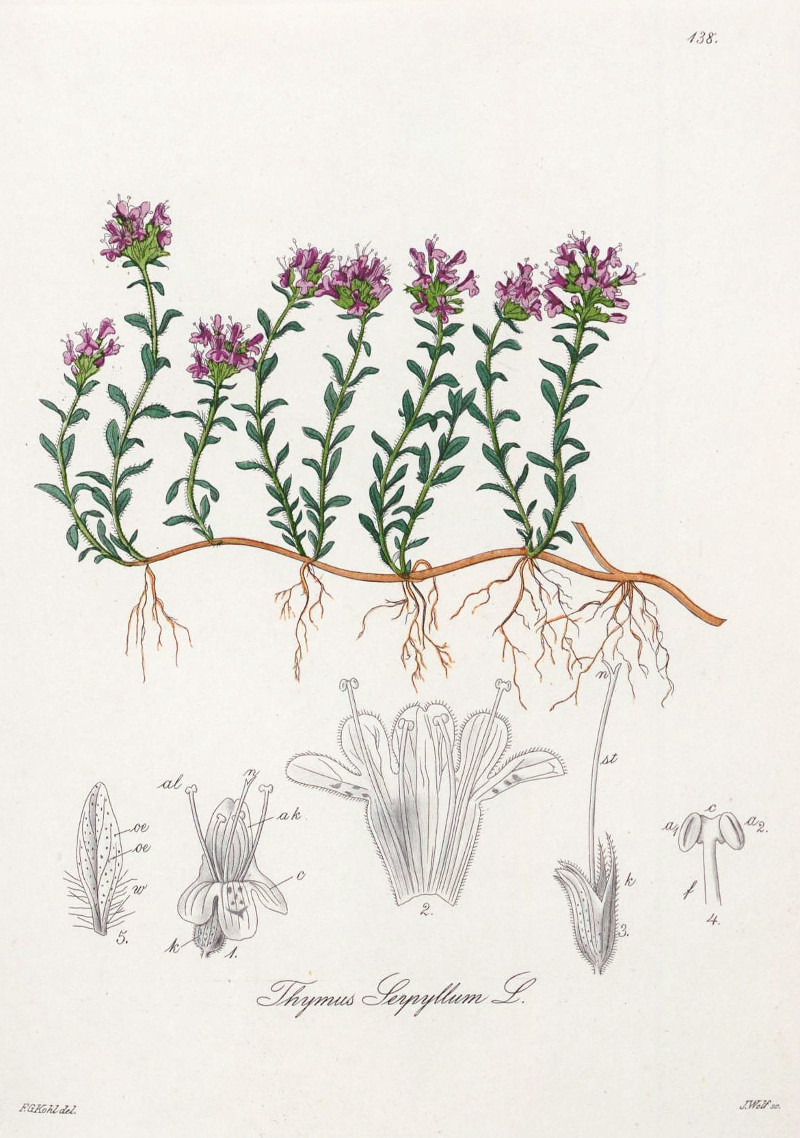Thymus serpyllum L. - syn.Thymus angustifolius Pers. - Lamiaceae
wild thyme, mother of thyme, Quendel, Feldthymian, Sand-Thymian, Wilder Thymian
Dwarf shrub, up to 15cm high; square twigs, those with flowers always pubescent around; leaves linear to narrow elliptic or obovate, 1-3mm broad; flowers small, pale pink or deeper red-violet, sometimes nearly white, whorl-like arranged at the top of the twigs.
Dried wild thyme, germ. Quendelkraut, lat. Serpylli herba, is used like common thyme against catarrh of the upper respiratory tract, bronchitis and whooping cough.
„The sand-thyme occurs on sandy dry grasslands, in dry pine forests and on silicate rock corridors in the cool temperate to Central, Eastern and Northern Europe… is scattered used as an ornamental plant in rock gardens, natural gardens and sandy areas.“
http://de.wikipedia.org/wiki/Sand-Thymian
„Thymus serpyllum L. grown in Kumaon region of Western Himalaya was investigated for essential oil content and
composition in different seasons. The oils of fresh samples were obtained by hydrodistillation. The yield of essential oil (% v/w) during different seasons varied from 0.07 to 0.28% with the highest in summer season, at vegetative stage. The oils were analyzed by GC and GC-MS. Major components of all the samples were thymol (19.4-60.1%), γ-terpinene (0.3-13.8%) and p-cymene (3.5-10.4%). The results clearly indicated that season has significant effect on quality and quantity of thyme oil.“
[Seasonal Variation in Essential Oil Content and Composition of Thyme, Thymus serpyllum L. Cultivated in Uttarakhand Hills. R S Verma, R K Verma, A Chauhan, A K Yadav, Indian Journal of Pharmaceutical Sciences (Impact Factor: 0.34). 03/2011; 73(2):233-5]
„…the essential oil was rich in carvacrol (30.90-46.16%) and its biogenetic precursors γ-terpinene [5.72-9.09%) and p-cymene (4.51-13.46%). Other constituents identified in significant amounts were β-caryophyllene, carvacrol methyl ether and (-)-β-bisabolene… The herb contains 0.1-0.6% of essential oil consisting of highly variable amounts of phenols (thymol and carvacrol), alcohols and monoterpene hydrocarbons. The EP standard to the oil content is not less than 3 ml/kg (~0.3%).“
[WESOŁOWSKA, ANETA, DOROTA JADCZAK, and MONIKA GRZESZCZUK. „Influence of distillation time on the content and composition of essential oil isolated from wild thyme (Thymus serpyllum L.).“ Herba Polonica 58.4 (2012).]
„… Based on the literature, thymol and carvacrol can be hardly considered as the main components due to
their low content. In the essential oil in wild thyme growing in Estonia: 0-2.9% and 0.1-3.5% correspondingly, and in 10 samples there was less than 1% of thymol, and in 14 samples there was less than 1% of carvacrol (Table 2). By contrast, we consider (E)-nerolidol (up to 70.1%), caryophyllene oxide (up to 45.0%), myrcene (up to 20.2%), (E)-b-caryophyllene (up to 13.3%), and germacrene D (up to 12.4%) as the main components of the essential oil of wild thyme growing in Estonia. In a few samples, there is relatively high content of geranyl acetate (only in one case 46.4%), linalyl acetate (in one case 31.4%), linalol (higher contents 4.4, 10.7 and 22.8%), etc.“
[Content and composition of the essential oil of Thymus serpyllum L.growing wild in Estonia, Ain Raal, Urve Paaver, Elmar Arak, Anne Orav, Medicina (Kaunas) 2004; 40(8), 795-799]

Kohl,F.G., Die officinellen Pflanzen der Pharmacopoea Germanica, t.138 (1891-1895)
http://plantgenera.org/species.php?id_species=1016173
Thymus serpyllum
© Rolf Marschner (2012),
www.botanische-spaziergaenge.at